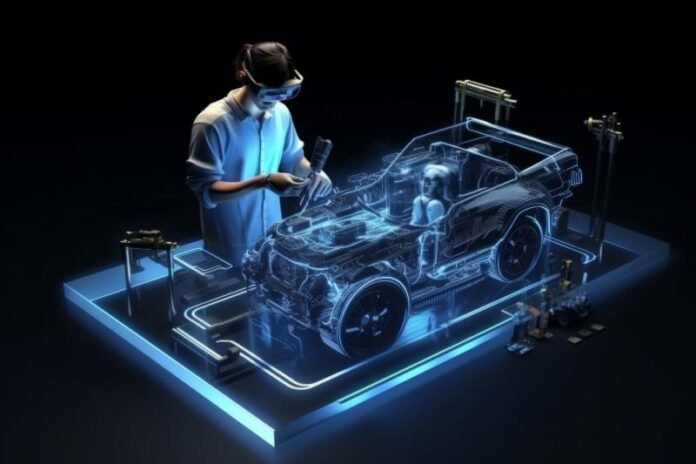In the rapidly evolving landscape of the automotive industry, technology is transforming the way vehicles are designed, manufactured, and operated. Automotive IT solutions have become integral to this transformation, driving efficiency, safety, and innovation. With the advent of 5G automotive technologies, the potential for even more significant advancements is on the horizon. This article explores the best features of automotive IT solutions, offering guidance on how to evaluate these features to fit various budgets.
Introduction to Automotive IT Solutions
Automotive IT solutions encompass a wide range of technologies and systems designed to enhance the functionality, safety, and efficiency of vehicles. These solutions include advanced driver-assistance systems (ADAS), in-vehicle infotainment (IVI) systems, telematics, predictive maintenance, cybersecurity measures, and more. The integration of 5G technology into these solutions is set to revolutionize the automotive industry by providing faster, more reliable connectivity.
The Importance of Automotive IT Solutions
Enhancing Safety
One of the primary goals of automotive IT solutions is to enhance vehicle safety. ADAS features such as automatic emergency braking, lane-keeping assist, and adaptive cruise control utilize sensors and software to prevent accidents and protect passengers.
Improving Efficiency
From optimizing fuel consumption to reducing emissions, automotive IT solutions play a crucial role in improving the efficiency of vehicles. Predictive maintenance systems, for instance, use data analytics to predict and prevent potential failures, thereby minimizing downtime and repair costs.
Elevating the Driving Experience
In-vehicle infotainment systems have transformed the driving experience, offering navigation, entertainment, and connectivity features that keep drivers and passengers engaged and informed.
Enabling Connectivity
Telematics and connectivity solutions allow vehicles to communicate with each other and with infrastructure, paving the way for innovations such as autonomous driving and smart traffic management.
Evaluating Automotive IT Solutions: Key Features
When evaluating automotive IT solutions, it is essential to consider a range of features that address different aspects of vehicle performance, safety, and user experience. Below, we delve into some of the most critical features to consider.
1. Advanced Driver-Assistance Systems (ADAS)
ADAS technologies are designed to enhance driver safety and comfort by automating and augmenting certain driving tasks. Key ADAS features include:
- Automatic Emergency Braking (AEB): Detects potential collisions and automatically applies the brakes to prevent or mitigate accidents.
- Lane Departure Warning (LDW) and Lane Keeping Assist (LKA): Alerts drivers if they unintentionally drift out of their lane and provides corrective steering input.
- Adaptive Cruise Control (ACC): Adjusts the vehicle’s speed to maintain a safe distance from the vehicle ahead.
- Blind Spot Detection (BSD): Warns drivers of vehicles in their blind spots during lane changes.
2. In-Vehicle Infotainment (IVI) Systems
IVI systems integrate entertainment, navigation, and connectivity features to enhance the in-car experience. Key components include:
- Touchscreen Displays: Centralized control panels that provide access to navigation, media, and vehicle settings.
- Voice Recognition: Allows drivers to control various functions without taking their hands off the wheel.
- Smartphone Integration: Supports connectivity with smartphones through platforms like Apple CarPlay and Android Auto.
- Advanced Navigation: Provides real-time traffic updates, route optimization, and points of interest.
3. Telematics
Telematics solutions involve the use of telecommunications and informatics to transmit data over long distances. Key features include:
- Vehicle Tracking: Uses GPS technology to monitor the location and movement of vehicles.
- Fleet Management: Helps fleet operators manage vehicle usage, maintenance, and logistics.
- Remote Diagnostics: Allows for real-time monitoring of vehicle health and performance.
- Usage-Based Insurance (UBI): Insurance premiums are adjusted based on driving behavior and mileage.
4. Predictive Maintenance
Predictive maintenance uses data analytics and machine learning to predict and prevent vehicle failures before they occur. Key features include:
- Condition Monitoring: Continuously monitors vehicle components for signs of wear and tear.
- Data Analytics: Analyzes historical and real-time data to identify patterns and predict failures.
- Maintenance Alerts: Provides timely notifications to schedule maintenance before issues become critical.
5. Cybersecurity
As vehicles become more connected, the need for robust cybersecurity measures becomes increasingly important. Key features include:
- Intrusion Detection Systems (IDS): Monitors for suspicious activity and potential cyber threats.
- Secure Communication Protocols: Ensures data transmitted between vehicles and infrastructure is encrypted and secure.
- Software Updates: Provides over-the-air (OTA) updates to address vulnerabilities and enhance security features.
- Authentication and Access Control: Ensures that only authorized users can access vehicle systems and data.
6. 5G Automotive Connectivity
The integration of 5G technology into automotive IT solutions promises to revolutionize vehicle connectivity. Key features include:
- Ultra-Low Latency: Enables real-time communication between vehicles and infrastructure, crucial for autonomous driving and V2X (vehicle-to-everything) communication.
- High Bandwidth: Supports the transmission of large amounts of data, allowing for advanced features such as HD mapping and real-time video streaming.
- Enhanced Reliability: Provides stable and reliable connectivity, reducing the risk of communication failures.
- Network Slicing: Allows for the creation of dedicated network segments for different automotive applications, ensuring optimal performance.
Evaluating Solutions Based on Budget
When evaluating automotive IT solutions, it is essential to consider the budget and prioritize features that provide the best value for money. Here, we offer guidance on how to evaluate solutions across different budget ranges.
Entry-Level Budget
For those with an entry-level budget, the focus should be on essential safety and efficiency features. Key considerations include:
- Basic ADAS Features: Look for vehicles equipped with essential ADAS features such as AEB, LDW, and BSD, which significantly enhance safety.
- Standard IVI Systems: Opt for IVI systems that offer basic navigation and media functions without advanced features like voice recognition or premium audio systems.
- Basic Telematics: Consider solutions that provide essential vehicle tracking and remote diagnostics capabilities.
- Predictive Maintenance: Look for basic condition monitoring systems that can help prevent major failures without the need for advanced data analytics.
- Cybersecurity: Ensure that the vehicle has basic cybersecurity measures, including secure communication protocols and OTA updates.
Mid-Range Budget
With a mid-range budget, it is possible to access more advanced features that offer enhanced safety, connectivity, and user experience. Key considerations include:
- Enhanced ADAS Features: Look for additional ADAS features such as ACC and LKA, which provide greater automation and comfort.
- Advanced IVI Systems: Consider systems with touchscreen displays, smartphone integration, and advanced navigation features.
- Comprehensive Telematics: Opt for solutions that offer fleet management, UBI, and more sophisticated remote diagnostics.
- Advanced Predictive Maintenance: Look for systems that utilize data analytics and machine learning to provide more accurate maintenance predictions.
- Enhanced Cybersecurity: Ensure that the vehicle has robust cybersecurity measures, including IDS and authentication controls.
Premium Budget
For those with a premium budget, the focus can be on cutting-edge technologies that offer the highest levels of safety, efficiency, and user experience. Key considerations include:
- Full Suite of ADAS Features: Opt for vehicles with a comprehensive range of ADAS features, including the latest innovations such as traffic jam assist and autonomous parking.
- Premium IVI Systems: Consider systems with high-resolution displays, advanced voice recognition, and premium audio systems.
- Advanced Telematics and Connectivity: Look for solutions that provide seamless connectivity, real-time data transmission, and advanced fleet management capabilities.
- Comprehensive Predictive Maintenance: Opt for systems that provide detailed analytics, real-time monitoring, and predictive insights to ensure optimal vehicle performance.
- Top-Tier Cybersecurity: Ensure that the vehicle is equipped with the latest cybersecurity measures, including advanced IDS, secure OTA updates, and comprehensive access control.
- 5G Connectivity: Consider vehicles that are equipped with 5G technology to benefit from ultra-low latency, high bandwidth, and enhanced reliability for future-proof connectivity.
The Impact of 5G Automotive Technologies
The integration of 5G technology into automotive IT solutions is set to have a profound impact on the industry. Here, we explore some of the key benefits and potential applications of 5G automotive technologies.
Enhanced Autonomous Driving
5G technology provides the ultra-low latency and high bandwidth necessary for real-time communication between autonomous vehicles and their surroundings. This enables more precise navigation, faster decision-making, and improved safety for autonomous driving.
Improved Vehicle-to-Everything (V2X) Communication
5G supports V2X communication, allowing vehicles to interact with each other and with infrastructure such as traffic lights and road signs. This facilitates advanced applications such as cooperative adaptive cruise control, platooning, and smart traffic management.
Real-Time Data Transmission
The high bandwidth of 5G enables the transmission of large amounts of data in real-time. This is particularly beneficial for applications such as HD mapping, real-time video streaming, and advanced driver monitoring systems.
Enhanced In-Vehicle Infotainment
5G technology supports seamless streaming of high-definition content, enhanced connectivity for passengers, and real-time cloud-based applications. This elevates the in-vehicle entertainment and connectivity experience to new heights.
Improved Predictive Maintenance
The real-time data transmission capabilities of 5G enable more accurate and timely predictive maintenance. Vehicles can transmit performance data to the cloud, where advanced analytics can predict potential issues and recommend proactive maintenance.
Future-Proof Connectivity
As automotive technologies continue to evolve, 5G provides a future-proof platform that can support emerging applications and innovations. This ensures that vehicles equipped with 5G technology remain relevant and capable of leveraging the latest advancements.
Conclusion
Automotive IT solutions are transforming the automotive industry, enhancing safety, efficiency, and the overall driving experience. From advanced driver-assistance systems to predictive maintenance and 5G connectivity, these solutions offer a wide range of features to meet diverse needs and budgets.
When evaluating automotive IT solutions, it’s crucial to prioritize features that align with your budget and requirements. Entry-level budgets may focus on essential safety features and basic connectivity, while mid-range budgets can access more advanced technologies such as advanced driver assistance and enhanced infotainment systems. Premium budgets offer access to cutting-edge features like comprehensive predictive maintenance and top-tier cybersecurity, along with the latest 5G connectivity.
The integration of 5G technology into automotive IT solutions represents a significant advancement, enabling enhanced autonomous driving, V2X communication, real-time data transmission, and future-proof connectivity. As 5G technology continues to mature, its impact on the automotive industry is expected to be profound, driving innovation and unlocking new possibilities for vehicle connectivity and automation.
In conclusion, automotive IT solutions play a crucial role in shaping the future of transportation, offering a wide range of features and capabilities to enhance safety, efficiency, and the overall driving experience. By evaluating these solutions based on budget and prioritizing key features, consumers and industry professionals can harness the power of technology to drive positive change in the automotive landscape. Whether it’s improving safety, enhancing connectivity, or enabling autonomous driving, automotive IT solutions are poised to revolutionize the way we think about transportation in the years to come.





